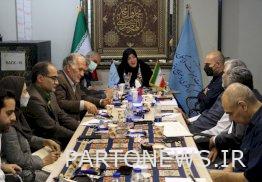Industrial designers can help artisans in rearranging, combining and designing products

According to the report of Aria’s Heritage reporter, the second specialized and scientific meeting of the Handicrafts Vice-Chancellor titled “Redesigning Handicrafts and Modern Applications beyond Decoration” was held today, Wednesday, the second of September 1401, with the presence of renowned and industrial designers in the Blue Hall of Handicrafts.
Maryam Jalali, Deputy Minister of Handicrafts and Traditional Arts of the country, said in this meeting: “In order to add different spaces to the meaning tree of handicrafts, the Deputy Minister of Handicrafts has prepared a series of meetings, of which today is the second specialized meeting with the presence of industrial designers who are the closest field to handicrafts. are held.”
He clarified: “If we consider handicrafts as the boundary between industry and art, industrial designers are the closest field that can help handicrafts in product rearrangement, combination and design of different products according to the needs of the society today.” We need their presence in the handicraft value creation cycle to complete all the links of the chain.”
The Deputy Minister of Handicrafts and Traditional Arts of the country added: “The most basic link in this chain is product design, which we should be able to add new ideas and modern knowledge to while preserving the originality and nature of handicrafts and save handicrafts from fading or freezing in the past.” Our craft should be vibrant and we should have a dynamic view towards it. This dynamism will not be implemented unless we bring the knowledge of the day to help it.
Jalali emphasized: “In order to dynamize handicrafts, we have a duty to change our perspective and look at it from a new perspective. This perspective does not fit into words, and besides producing literature, we must be able to turn this literature into a project.” Holding specialized meetings, while having an advantage and benefit for the production of literature, we should be able to turn it into an operation. All our efforts are to make every idea that is held in this meeting become a project and enter the life of handicraft ecosystem in a fully operational and visual way.”
“I consider myself responsible for coordinating your ideas,” he stated. The output of every culture and the result of every culture’s taste and knowledge is its handicrafts. If we want to stay at one point and cannot innovate, create products and play a role in the value supply chain, we are definitely doomed. We need a new perspective.”
The deputy of handicrafts and traditional arts of the country continued: “Sometimes, the nature of handicraft work should be based on current knowledge. I request industrial designers to establish inter-discipline and multi-discipline connection and solve problems.
Jalali stated: “Handicrafts were once biological and life industries and were not decorative. We could not be the stem cells for craft workshops so that the economy is based on knowledge. We need designers because they pay attention to scientific aspects, aesthetics and identity. We have to consider these three aspects at the same time.”
He said: “These meetings should have a thinking room and outlet. These outputs can be at the level of policy, planning, design and product production.
In the following, activists and industrial designers in the field of handicrafts about the link between industrial designers and the field of handicrafts, exchange of experiences, packaging, attention to the economy of handicrafts after oil, research and typology of handicrafts in doctoral theses, revival and reweaving of handicraft designs, filling the gap between designers Industrial and handicrafts raised some points.

